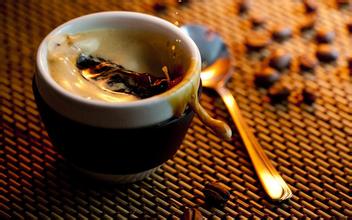One-year planting and fertilization of coffee trees in Yunnan-where can coffee trees be planted in China
One-year planting and fertilization of coffee trees in Yunnan-where can coffee trees be planted in China
Coffee (Xoffea arabica Linn) Coffee is a perennial evergreen shrub or small tree of Rubiaceae. It is a horticultural perennial cash crop with the characteristics of fast growth, high yield, high value and wide market. Wild coffee trees can grow to a height of 5 to 10 meters, but coffee trees planted on the manor are often cut to a height of less than 2 meters in order to increase the amount of fruit and facilitate harvesting. Coffee tree opposite leaves are long oval, smooth leaves, the end of the branch is very long, few branches, and the flowers are white, open at the base of the petiole connecting the branch. The ripe coffee berries look like cherries and are bright red with sweet flesh and contain a pair of seeds, namely coffee beans (Coffee Beans). Coffee varieties can be divided into small-grain, medium-grain and large-grain species, the former contains low caffeine content and strong flavor, while the latter two have high caffeine content but poor flavor. At present, coffee sold in the world is generally made of small and medium seeds in different proportions, usually 70% of medium seeds, mainly caffeine, and 30% of small seeds, mainly for their aroma. Each coffee variety generally has a few to a dozen variants. Coffee is more resistant to shade and cold, but not resistant to light, drought and disease. Coffee contains nine kinds of nutrients, such as caffeine, protein, crude fat, crude fiber and sucrose. As a beverage, coffee is not only mellow and delicious, slightly bitter and sweet, but also can excite nerves and dispel fatigue. In medicine, caffeine can be used as an anesthetic, stimulant, diuretic and cardiotonic, as well as to help digestion and promote metabolism. The pulp of coffee is rich in sugar and can be used to make sugar and alcohol. Coffee flowers contain essential oils, which can extract high-grade spices.
When looking for places suitable for coffee trees, experienced coffee gardeners often look at the growth status of local tropical cash crops such as mangoes, bananas and olives, as well as "indicator plants" such as mulberry and acacia trees. In addition, with the concept of "health, environmental protection, organic" gradually taking root in the hearts of the people, we also need to detect the concentration of pollutants in the soil.
Apart from the climate, topography is the second most important factor we need to examine. Coffee trees are not suitable to grow on the cold current passageway, open to the south, frost-free and calm hillsides in winter are undoubtedly the first choice for planting, but the backside is sometimes a good choice because of the slower growth period. Although I have seen many slopes of more than 30 degrees in coffee growing areas around the world, the slope is too steep for planting, harvesting and soil conservation. When planting coffee trees in Yunnan, China, the slope is emphasized to be less than 25 degrees.
Soil conditions are also crucial. Coffee trees belong to shallow root plants, and the soil is rich in organic matter (with strong fertility), rich in water vapor (and smooth drainage), deep soil layer (usually above lm) and weakly acidic (the soil pH value of coffee planting in Yunnan, China is generally between 5.5 and 6.5). Guatemala, Brazil and Colombia, as well as Hawaii, the Blue Mountains of Jamaica, Java of Indonesia and Yunnan of China can become excellent coffee producing areas, all related to the possession of this kind of volcanic or forest soil. In order to protect the ecological environment as much as possible, it is usually not suitable to plant coffee trees on hilltops and ridges.

Important Notice :
前街咖啡 FrontStreet Coffee has moved to new addredd:
FrontStreet Coffee Address: 315,Donghua East Road,GuangZhou
Tel:020 38364473
- Prev

Facing the third wave of coffee, where is the direction of coffee joining?
The third wave of coffee has swept across China, especially in first-tier cities, there have been a group of advocates and operators who really love coffee, who insist on providing coffee from the country of origin, have their own technology, and spread authentic coffee culture. so they are more able to attract consumers who really like coffee! Caffe Pascucci, a century-old coffee brand from Italy, is a fine one.
- Next

The general situation and prospect of Vietnam's coffee industry on the basis of ranking second in output and export volume in the world.
The overall goal is: on the basis of ranking second in output and export volume in the world, Viet Nam will double its export and output value, change its growth mode, improve its competitiveness and added value in the direction of modernization and diversification, and steadily achieve economic, social and environmental benefits. The 2020 target is to control the total area of coffee cultivation at 600000 hectares, with a unit yield of 2.7t / ha, with a total output of 2.7t / ha.
Related
- Why can American refills for free? The difference between Americano and American drip pot coffee
- Being chased out of the rain in front of Starbucks?! Store: Sheltering from rain under umbrellas poses a safety hazard
- The white moonlight has changed?! Lucky launches "Big Winter Pear American"
- Hand-brewed coffee three-stage method, high-sweet and universal brewing method to share! What does the high sweet water level of hand-brewed coffee mean?
- What is the difference between raw, refined and full espresso coffee? How to extract espresso and taste good?
- A complete list of coffee bean names and their meanings! What is Yejia Shefi coffee? Where is Mantelin coffee?
- What grade does Arida Manor Kaduai coffee beans belong to? What treatment is Arida ASD slow anaerobic sun exposure?
- The milk tea cup becomes smaller?! Overlord Tea Girl launches a new "Return to Yunnan" series
- Accused of selling counterfeit and high-priced coffee beans! Well-known boutique coffee brand "Oukelao" bowed and apologized!
- How to make espresso dumplings? Can I eat coffee and glutinous rice balls together?

